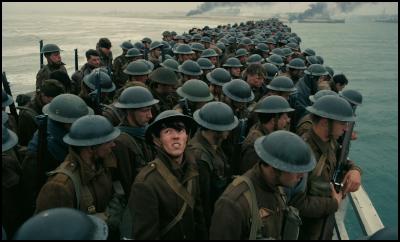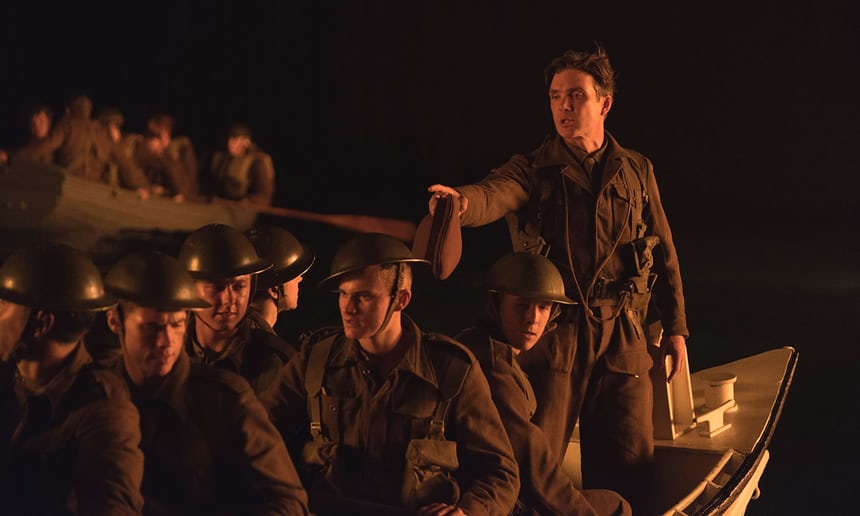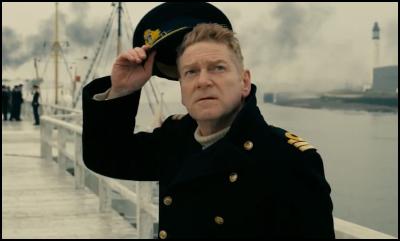
The British have an extraordinary
penchant for celebrating catastrophic military defeats. It
is not only the Battle of Hastings, the Charge of the Light
Brigade, and Gallipoli that have become immortalized in
prose, poetry, and movies. There have been literally legions
of legendary, stiff upper-lipped, brave and valiant warriors
who somehow soldier on, live to fight another day, snatch
victory from the jaws of defeat, etc. Consider, to take but
one particularly nauseating example, William Cowper's
rhapsodic poem on the 1782 sinking of the Royal
George, which capsized at Spithead quayside with the
loss of about 900 lives - a patriotic lament by a demented
and suicidal depressive for those pour souls whose lives
were lost without even engaging in combat. Deeply religious
and possibly hermaphroditic, Cowper attributed all such
failures to the direct intervention of God, who as he
remarked in a famous hymn, "moves in mysterious ways, his
wonders to perform."
Director Christopher Nolan, never one to do things by halves, is having none of that nonsense. He has produced a shattering spectacle of dismal, doomed, and desolate failure that plunges us straight into the middle of the chaotic evacuation of the British Expeditionary Force from northern France by an enormous flotilla of small civilian craft. As The Guardian's Peter Bradshaw commented, "It is part disaster movie, part compressed war epic, and all horribly appropriate for these Brexit times."
Nolan's intricate screenplay seamlessly interweaves three narrative arcs: the landlocked infantry stranded on the beaches; the civilians who assist in the naval evacuation; and the aerial combat taking place in the skies above. In an early interview for Premiere magazine, Nolan indicated that "For the soldiers who embarked in the conflict, the events took place on different temporalities. On land, some stayed one week stuck on the beach. On the water, the events lasted a maximum day; and if you were flying to Dunkirk, the British spitfires would carry an hour of fuel. To mingle these different versions of history, one had to mix the temporal strata. Hence the complicated structure; even if the story is very simple. Do not repeat it to the studio: it will be my most experimental film."
However "experimental" Nolan's original intent, the plethora of unnamed and generic Everymen that populate the script crop up as thick and fast as the fusillades of shrapnel that ping, rattle, and ricochet around the theatre in full-throttle Dolby Digital Surround Sound. We are immediately and metaphorically parachuted into the middle of the ear-piercing action, as a plucky squaddie (Fionn Whitehead) scrambles desperately through the Dunkirk streets and down to the strands, only to witness the sobering scene of hundreds of thousands of marooned French and British troops awaiting their deliverance. But there are no ships there to rescue them and no air cover to prevent them being strafed and bombed by dastardly and anonymous Heinkels and Messerschmidts. Plucky RAF pilots Tom Hardy and Jack Lowden are in fact taking desperate risks with a failing fuel gauge in order to engage the enemy overhead, while a grizzled naval officer broodingly scans the horizon below (Kenneth Branagh, channelling his inner Jack Hawkins from The Cruel Sea). Meanwhile, plucky weekend yachtie Mark Rylance leaps aboard his little cruiser in his three-piece suit and tie, rescues the shell-shocked (and no longer quite so plucky) Cillian Murphy, and endures a sombre sacrifice, only to find it falsely sanctified in the newspapers.

Traditionally, the Dunkirk evacuation has been portrayed in terms of the doughty underdogs who somehow manage to redeem themselves from a colossal disaster. The process of mythologizing the valiant armada of amateur sailors has supplanted the reality of a British army decimated by Wehrmacht stormtroopers hopped up on amphetamines, and a military command humiliated by the fact that it was only Hitler’s halt of the German advance that enabled the evacuation to take place at all. But it’s not just Dunkirk that has been mythologized in this manner. WW2 as a whole has been co-opted as the standard bearer of English exceptionalism and isolationism. Winston Churchill has been elevated to the Brexiters’ patron saint:- from Nigel Farage persuading Trump to put Churchill’s bust back in the Oval Office; through Boris Johnson’s adulatory biography that likened the EU to Hitler and claimed Churchill would have joined him on the Brexit bus; to the reptilian Michael Gove bemoaning the lack of emphasis on eminent Victorians, the Britain Empire, and “our island story” in the history curriculum (“This trashing of our past has to stop,” he complained).
It certainly has in the movies. Ridley Scott is covering the Battle of Britain, Brian Cox’s Churchill has just finished its cinema run, while John Lithgow received an Emmy nomination for his Churchill portrayal in The Crown. Gary Oldman has recently wrapped Darkest Hour, Joe Wright's forthcoming war drama, which will inevitably include yet another rendition of the “we will fight on the beaches” speech. At least Nolan relegates the famous words into the voiceover of an ordinary soldier at the end of his film.
Nostalgia has become a major component of British cinema with no serious questioning of England's ossified image of its imperial past, from country house/royal family nostalgia (The King's Speech, Victoria and Abdul, and the almost interminable Downton Abbey) to postwar heroes such as James Bond, still peddling the “nobody does it better” fantasy of colonial supremacy and overcooked virility. To his credit, Nolan eschews such jingoistic flag-waving in favour of a more complex account of events. There is plenty of heroism, courage, and sacrifice in evidence, but the movie also acknowledges the chaos, shame, and cowardice. There is xenophobia (“English only!” shouts one naval officer, turning French soldiers away from the rescue ships), but it is nicely balanced by Branagh’s sense of stoic solidarity as he watches the last British troops sail home (“I’m staying … for the French").

Nolan says he approached the film “from the point of view of the pure mechanics of survival rather than from the politics of the event”. Unlike Leslie Norman's chauvinistic Dunkirk (starring John Mills and Richard Attenborough), he is not interested in developing chipper, morale-raising characters. Nolan's primary focus is on recreating the profound sense of panic and confusion amid an apocalyptic landscape that is more indebted to Steven Spielberg's Saving Private Ryan and Joe Wright’s Atonement. He presents a bloated panorama, littered with zombiefied casualties, and perfectly accompanied by Hans Zimmer's groaning score, which eventually degenerates into an elegaic theme borrowed from Elgar.
Not normally known for subtle understatement, this is Zimmer's sixth collaboration with Nolan and for once he remains relatively restrained, creating a constant keening lament that imitates the sickening screams of dive bombers and the queasy turning of the tides in counterpoint to the ear-shattering artillery bombardments and machine-gun fire. The ticking sounds that serve as a central acoustic motif were recorded by Zimmer from one of Nolan's own pocket watches, then put into synthesizers and distorted in different ways for the soundtrack. The stakes may be enormous, the anxiety palpable, and the tension almost unbearable, but fittingly discretion remains the better part of valour.
Displaying a somewhat surprising level of cinematic literacy, Nolan has cited such classic silent movies as Erich von Stroheim's Greed, DW Grifiths' Intolerance, and FW Murnau's Sunrise as inspirations: "I spent a lot of time reviewing the silent films for crowd scenes - the way extras move, evolve, how the space is staged and how the cameras capture it, the views used". He also studied Robert Bresson's A Man Escaped and Pickpocket, as well as Henri-Georges Clouzot's The Wages of Fear, in order to dissect the process of creating suspense through attention to detail and the use of minimal dialogue. Together with his astonishing cinematographer Hoyte Van Hoytema, Nolan focused on creating as great an atmosphere of authenticity as possible, putting an IMAX camera on the cockpit and wing of an actual Spitfire fighter plane, and floating hand-held cameramen around in the water with the actors.
To recreate the evacuation of almost 400,000 allied troops, Nolan employed more than 1,500 extras. He also used real naval destroyers instead of CGI for the naval sequences and cardboard cut-out props of soldiers and vehicles to create the illusion of a far larger army. Over 50 boats were utilized (the most that has ever been put on film) - some of which were the original 'Little Ships' that survived Operation Dynamo. Other warships included the French T-47-class destroyer 'Maillé-Brézé,' portraying british destroyers 'Vivacious' and 'Vanquisher'; the Dutch Dokkum-class minesweepers 'Naaldwijk' (for the minesweeper 'Britomart' ) and 'Sittard' (for destroyers 'Havant' and 'Jaguar'); the Dutch multipurpose 'Castor' for the destroyer 'Basilisk'; the British Harbour Defence Motor Launch 'Medusa'; and the British Motor Torpedo Boat MTB102 (present at the actual Dunkirk evacuation and the smallest vessel to become a flagship in the Royal Navy when Admiral Frederic Wake-Walker transferred to her after his previous flagship was disabled). The accumulated result is a film that revels not only in its sonic and visual virtuosity, but also its historical accuracy and detail.
In tactical military terms, Dunkirk is mostly static, as much of the battle is over before the film has even begun. Instead, Nolan engulfs his audience in the mindless chaos and horror of the evacuation by means of several visually stunning set pieces: a mole crammed with soldiers that stretches out into the churning sea, exposed to enemy aircraft in an architectural expression of doomed longing; groups of stunned troopers lingering by the froth scum froth at the surf’s edge, like the ragged leftovers of some terrible nuclear disaster; and the survivors who scramble aboard a destroyer to be greeted with cups of tea and bread and jam (tiny rectangles of surreal red speckling the predominantly brown, green, grey, and khaki colour scheme) - only to find themselves sinking in the drink yet again. With its largely context-free and time-leaping narratives, minimal dialogue, and lack of gore, Dunkirk is hardly another Hacksaw Ridge, but whether Warner Bros - whose marketing department has been actively seeding comparisons with Stanley Kubrick's Paths of Glory - will be proven correct about Nolan inheriting the master's mantle remains to be seen.
He certainly shares Kubrick's obsession with utilizing the latest cinematic and technical developments on a grand scale. Continuing his preference for film over digital formats, Nolan shot Dunkirk with a combination of 15/70mm IMAX film and Super Panavision 65mm film in order to achieve the maximum possible quality and depth of image. Following Wes Anderson's The Master and Quentin Tarantino's The Hateful Eight, it is the third major motion picture of the decade to be primarily shot and screened theatrically in 70mm. The 70mm film prints will be shown at 125 70mm theaters, surpassing the previous record of 100 by The Hateful Eight in 2015, and the widest film release in this format since Ron Howard's Far and Away in 1992. And one final record worth mentioning - Nolan received a $20 million salary against 20% of the box office gross, the biggest deal for any director since Peter Jackson received the same amount for King Kong.
ENDS



 Te Whatu Ora Health NZ: Health Warning – Unsafe Recreational Water Quality At South Bay And Peketā Beaches And Kahutara River Upstream Of SH1
Te Whatu Ora Health NZ: Health Warning – Unsafe Recreational Water Quality At South Bay And Peketā Beaches And Kahutara River Upstream Of SH1 Wikimedia Aotearoa NZ: Wikipedian At Large Sets Sights On Banks Peninsula
Wikimedia Aotearoa NZ: Wikipedian At Large Sets Sights On Banks Peninsula Water Safety New Zealand: Don’t Drink And Dive
Water Safety New Zealand: Don’t Drink And Dive NZ Olympic Committee: Lydia Ko Awarded Lonsdale Cup For 2024
NZ Olympic Committee: Lydia Ko Awarded Lonsdale Cup For 2024 BNZ Breakers: BNZ Breakers Beaten By Tasmania Jackjumpers On Christmas Night
BNZ Breakers: BNZ Breakers Beaten By Tasmania Jackjumpers On Christmas Night Te Whatu Ora Health NZ: Health Warning – Unsafe Recreational Water Quality At Roto Kohatu Reserve At Lake Rua
Te Whatu Ora Health NZ: Health Warning – Unsafe Recreational Water Quality At Roto Kohatu Reserve At Lake Rua